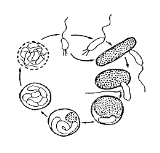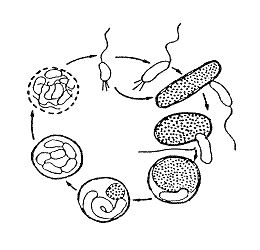
Bdellovibrio
Encyclopedia
Bdellovibrio is a genus
of Gram-negative
, obligate aerobic
bacteria.
One of the more notable characteristics of this genus is that members parasitize
other Gram-negative bacteria by entering into their periplasmic space
and feeding on the biopolymers, e.g. proteins and nucleic acids, of their hosts. After entering the periplasmic space
of its host the Bdellovibrio bacterium forms a structure called a bdelloplast, which consists of both predator and prey. The predator cell can remain dormant at this stage, without affecting the viability of the host. In most cases, though, Bdellovibrio devours its prey and moves on. Because of this, Bdellovibrio can be considered bacterial predators, in addition to parasites.
Bdellovibrio species are found in river water or soil and live an intraperiplasmic existence. To enrich for Bdellovibrio use NB/500 (nutrient broth at 1:500 dilution) and mix with hot soft agar
with E. coli at 30 °C for one week.
Under the microscope, a Bdellovibrio appears as a comma-shaped motile rod that is about 0.3-0.5 by 0.5-1.4 µm
in size with a barely discernible flagellum
. Colonies of Bdellovibrio show up as a growing clear plaque in an E. coli lawn
.
Another notable feature of Bdellovibrio is the sheath that covers its flagellum. This is a rare characteristic among bacteria. Flagellar motility stops after Bdellovibrio penetrates its prey. In some cases the flagella is shed; in others it protrudes from the outer membrane of the prey cell.
 Bdellovibrio attacks other gram-negative bacteria by colliding with them at speeds recorded up to 160 µm/s, or over 100 times their length per second. It swims using a single sheathed polar flagellum with a characteristic dampened filament waveform. After a collision, the Bdellovibrio cell attaches to the prey cell outer membrane and peptidoglycan layer, after which it creates a small hole in the outer membrane. The Bdellovibrio cell then enters the host periplasmic space. It remains reversibly attached to it for a short "recognition" period. After the recognition period, it becomes irreversibly attached via the pole opposite the flagellum. Once inside the periplasm, the Bdellovibrio cell seals the membrane hole and converts the host cell to a spheroblast. A mixture of hydrolytic enzymes is applied in a locally targeted manner that prevents excessive damage to the prey and counters diffusion. This two-cell complex is now called a bdelloplast. The Bdellovibrio cell uses hydrolytic
Bdellovibrio attacks other gram-negative bacteria by colliding with them at speeds recorded up to 160 µm/s, or over 100 times their length per second. It swims using a single sheathed polar flagellum with a characteristic dampened filament waveform. After a collision, the Bdellovibrio cell attaches to the prey cell outer membrane and peptidoglycan layer, after which it creates a small hole in the outer membrane. The Bdellovibrio cell then enters the host periplasmic space. It remains reversibly attached to it for a short "recognition" period. After the recognition period, it becomes irreversibly attached via the pole opposite the flagellum. Once inside the periplasm, the Bdellovibrio cell seals the membrane hole and converts the host cell to a spheroblast. A mixture of hydrolytic enzymes is applied in a locally targeted manner that prevents excessive damage to the prey and counters diffusion. This two-cell complex is now called a bdelloplast. The Bdellovibrio cell uses hydrolytic
enzyme
s to break down the host cell molecules, which it uses to elongate and form a filament. When the host cell nutrients are exhausted, the filament septates to form progeny Bdellovibrios. The progeny become motile before they lyse the host cell and are released into the environment. The entire life cycle takes from one to three hours, and produces an average of 3-6 progeny cells are from a single E. coli, or up to 80 from larger prey, such as filamentous E. coli.
Bdellovibrio bacteriovorus was first described by Stolp and Starr in 1963. Two other species, Bdellovibrio starrii and Bdellovibrio stolpii, have been moved to a separate genus Bacteriovorax.
Genus
In biology, a genus is a low-level taxonomic rank used in the biological classification of living and fossil organisms, which is an example of definition by genus and differentia...
of Gram-negative
Gram-negative
Gram-negative bacteria are bacteria that do not retain crystal violet dye in the Gram staining protocol. In a Gram stain test, a counterstain is added after the crystal violet, coloring all Gram-negative bacteria with a red or pink color...
, obligate aerobic
Obligate aerobe
An obligate aerobe is an aerobic organism that requires oxygen to grow. Through cellular respiration, these organisms use oxygen to oxidize substances, like sugars or fats, in order to obtain energy. During respiration, they use oxygen as the terminal electron acceptor...
bacteria.
One of the more notable characteristics of this genus is that members parasitize
Parasitism
Parasitism is a type of symbiotic relationship between organisms of different species where one organism, the parasite, benefits at the expense of the other, the host. Traditionally parasite referred to organisms with lifestages that needed more than one host . These are now called macroparasites...
other Gram-negative bacteria by entering into their periplasmic space
Periplasmic space
The periplasmic space or periplasm is a space between the peptidoglycan cell wall and inner membrane of Gram-negative bacteria or the equivalent space outside the inner membrane of Gram-positive bacteria. It may constitute up to 40% of the total cell volume in Gram-negative species, and is...
and feeding on the biopolymers, e.g. proteins and nucleic acids, of their hosts. After entering the periplasmic space
Periplasmic space
The periplasmic space or periplasm is a space between the peptidoglycan cell wall and inner membrane of Gram-negative bacteria or the equivalent space outside the inner membrane of Gram-positive bacteria. It may constitute up to 40% of the total cell volume in Gram-negative species, and is...
of its host the Bdellovibrio bacterium forms a structure called a bdelloplast, which consists of both predator and prey. The predator cell can remain dormant at this stage, without affecting the viability of the host. In most cases, though, Bdellovibrio devours its prey and moves on. Because of this, Bdellovibrio can be considered bacterial predators, in addition to parasites.
Bdellovibrio species are found in river water or soil and live an intraperiplasmic existence. To enrich for Bdellovibrio use NB/500 (nutrient broth at 1:500 dilution) and mix with hot soft agar
Agar
Agar or agar-agar is a gelatinous substance derived from a polysaccharide that accumulates in the cell walls of agarophyte red algae. Throughout history into modern times, agar has been chiefly used as an ingredient in desserts throughout Asia and also as a solid substrate to contain culture medium...
with E. coli at 30 °C for one week.
Under the microscope, a Bdellovibrio appears as a comma-shaped motile rod that is about 0.3-0.5 by 0.5-1.4 µm
Micrometre
A micrometer , is by definition 1×10-6 of a meter .In plain English, it means one-millionth of a meter . Its unit symbol in the International System of Units is μm...
in size with a barely discernible flagellum
Flagellum
A flagellum is a tail-like projection that protrudes from the cell body of certain prokaryotic and eukaryotic cells, and plays the dual role of locomotion and sense organ, being sensitive to chemicals and temperatures outside the cell. There are some notable differences between prokaryotic and...
. Colonies of Bdellovibrio show up as a growing clear plaque in an E. coli lawn
Bacterial lawn
Bacterial lawn is a term used by microbiologists to describe the appearance of bacterial colonies when all the individual colonies on a petri-dish agar plate merge together to form a field or mat of bacteria...
.
Another notable feature of Bdellovibrio is the sheath that covers its flagellum. This is a rare characteristic among bacteria. Flagellar motility stops after Bdellovibrio penetrates its prey. In some cases the flagella is shed; in others it protrudes from the outer membrane of the prey cell.

Hydrolysis
Hydrolysis is a chemical reaction during which molecules of water are split into hydrogen cations and hydroxide anions in the process of a chemical mechanism. It is the type of reaction that is used to break down certain polymers, especially those made by condensation polymerization...
enzyme
Enzyme
Enzymes are proteins that catalyze chemical reactions. In enzymatic reactions, the molecules at the beginning of the process, called substrates, are converted into different molecules, called products. Almost all chemical reactions in a biological cell need enzymes in order to occur at rates...
s to break down the host cell molecules, which it uses to elongate and form a filament. When the host cell nutrients are exhausted, the filament septates to form progeny Bdellovibrios. The progeny become motile before they lyse the host cell and are released into the environment. The entire life cycle takes from one to three hours, and produces an average of 3-6 progeny cells are from a single E. coli, or up to 80 from larger prey, such as filamentous E. coli.
Bdellovibrio bacteriovorus was first described by Stolp and Starr in 1963. Two other species, Bdellovibrio starrii and Bdellovibrio stolpii, have been moved to a separate genus Bacteriovorax.

